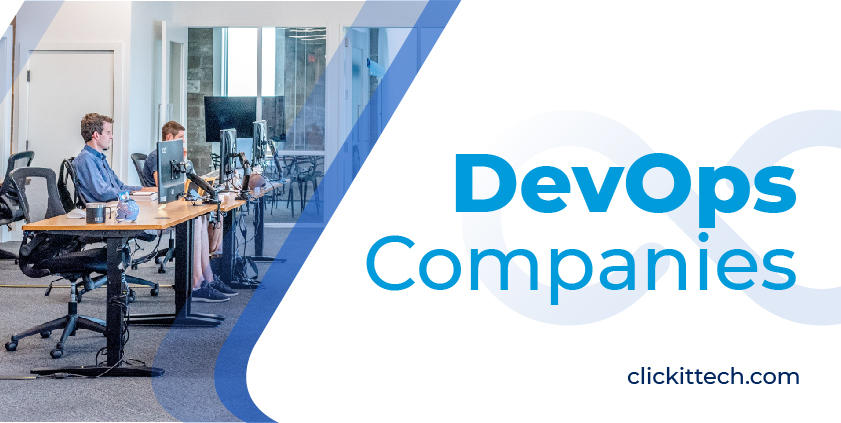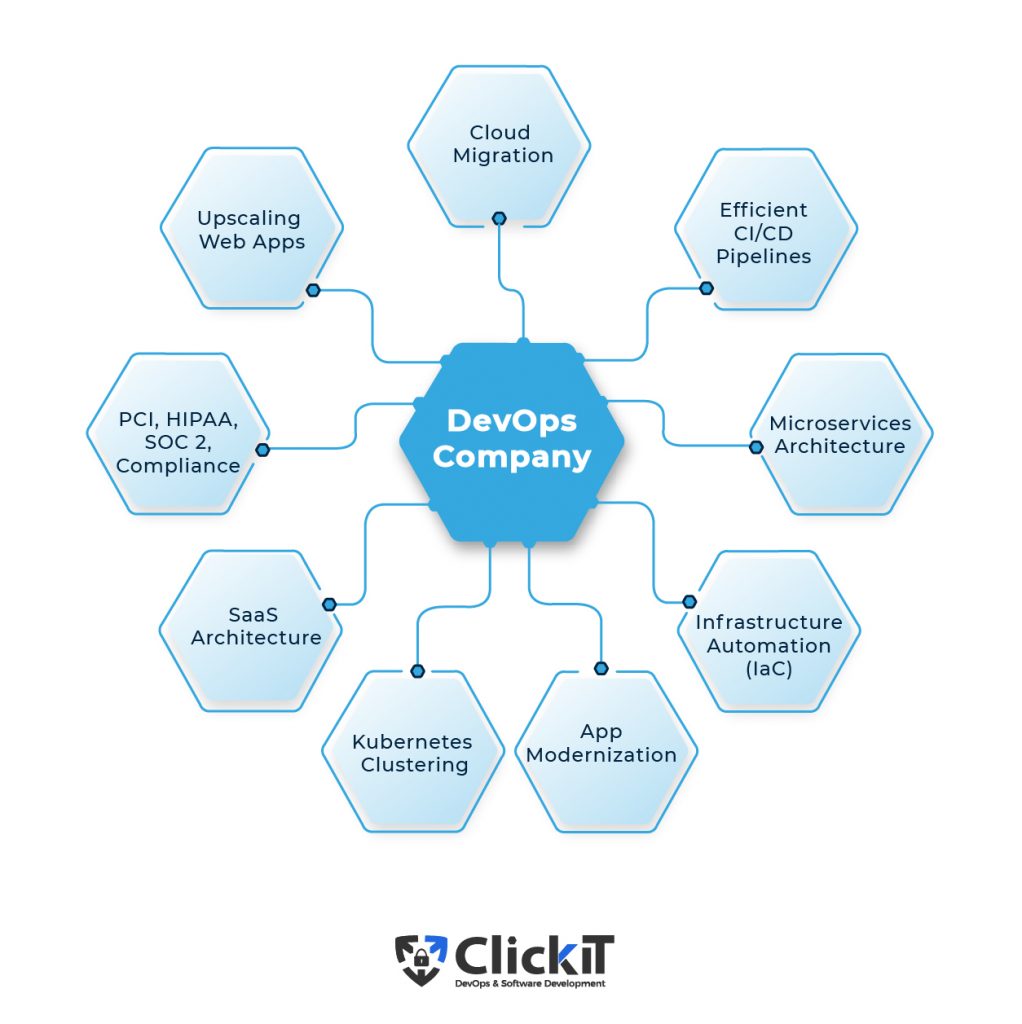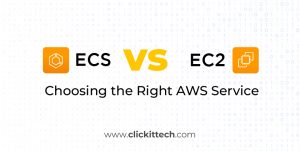what is a DevOps Company? How can DevOps companies help you? The Internet revolution in the 90s paved the way for a digital world. The advent of cloud computing technology has expedited this digital transformation. Today, you’ll find hundreds of IT products delivered over the cloud as a service. As more and more technologies come into the picture, IT management gets complex. This is the reason for the increasing popularity of DevOps in recent times and DevOps companies in USA.
DevOps enables organizations to facilitate seamless collaboration across business processes, automate work pipelines, efficiently monitor and manage workflows while optimizing resources to the core. However, the IT market is flooded with multiple DevOps companies in california. As such, it is important for every organization to choose the right DevOps company for their business needs.
Table of contents
- Why do you need a DevOps Company? How DevOps companies can help you?
- How to choose DevOps companies for your enterprise?
- DevOps collaboration models
- Why a nearshore DevOps engineer can be a better strategy than an in-house DevOps engineer?
- Offshore DevOps Services Vs Nearshore DevOps Services
- Frequently Asked Questions (FAQ)
This blog is a guide to choosing the right DevOps company in the USA, California in particular.
Why do you need a DevOps Company? How DevOps companies can help you?
DevOps is a broader term comprising a set of methodologies or practices to facilitate continuous development, continuous testing and continuous delivery, and infrastructure automation. However, most organizations lack the expertise or budgets to implement the right DevOps strategies. This is where DevOps companies come to the rescue.
Here are a few important areas that DevOps companies in USA that can help you with.
DevOps companies do: Seamlessly migrate to the Cloud
As cloud technology becomes an integral part of business processes, migrating to the cloud is the first step for most businesses. The process involves proper planning and technical execution.
Firstly, it is important to form a project migration team headed by a Migration Architect. The Migration Architect is responsible for identifying refactoring options, data migration strategies, the right cloud tool stack and defining migration priorities.
Secondly, you need to determine the cloud deployment model. You can choose a public, private, hybrid or a multi-cloud option. A single cloud vendor simplifies cloud management but you’ll run into vendor lock-in. Distributing your applications across multiple cloud vendors allows you to leverage key capabilities of each cloud platform. However, you should be able manage various cloud APIs and gain better visibility across the infrastructure.
Thirdly, you need to determine whether to choose deep cloud integration or a shallow cloud integration. When you just lift and shift the application to the cloud, it is called a shallow cloud integration. Here, the app simply moves places. When you make changes to application architecture to leverage cloud server and load balancer capabilities, it is called a deep cloud integration. Fourthly, you need to identify migration priorities such as moving a single app first or migrating the entire app stack.
“A DevOps company helps you to seamlessly migrate to the cloud”
The next step is to determine data migration strategies. You’ll have to either set up one-way sync or two-way sync to the data residing in the cloud and on-premise and make changes when the migration is completed. After migrating to the cloud, you should set up the right KPIs to monitor and analyze business performance in the cloud. Choosing the right DevOps Metrics and KPIs is a challenging task.
DevOps companies do: Automate infrastructure leveraging Infrastructure as Code (IaC)
As businesses scale up, they struggle to monitor and manage the infrastructure, owing to shrinking IT budgets and lack of expertise. Infrastructure as Code (IaC) has become quite popular in recent times as it enables businesses to automate infrastructure management.
In the software environment, the same binaries are created every time the same source code is applied. The same principle is applied to infrastructure management wherein the resources are defined in the config files in a descriptive model. It removes the traditional process of manually configuring systems, provisioning and configuring them via code. It allows organisations to instantly set up environments and ensure that they are always maintained at the desired state.
Firstly, developers prepare configuration parameters, defining them in a domain-specific language (DSL) and pushing them to the code repository, the managing API or server which are then picked up by the IaC platform to create the environment. These parameters are saved in files called Manifests to be used again instead of configuring them every time.
IaC reduces the high costs involved in setting up the required infrastructure, makes provisioning quicker, and brings environmental consistencies into reality. Terraform and CloudFormation are the most popular IaC tools that enable organizations to easily automate infrastructure management.
IaC being relatively new, there are not many experts in this field. A good DevOps company will help you to efficiently manage IaC tasks.

DevOps company does: Build efficient CI/CD Pipelines
In today’s Cloud and DevOps era, products and services are continuously built and deployed. As such, the entire development has to be automated.
The CI/CD process is about introducing automation into the software development pipeline, right from coding and testing to delivery and deployment, to enable organizations to deliver software faster and better. In this process, CI stands for continuous integration and CD stands for continuous delivery.
In the CI stage, automation is introduced to developer tasks wherein each developer writes the code and pushes it to a central repository. Automated tests are run on the code and successful code scripts are committed. Software is incrementally developed here.
It’s important to highlight that continuous delivery and continuous deployment are interchangeably used wrongly. Continuous delivery talks about the automated processes of the operations department wherein successfully tested code is applied to a central code repository and image containers and then pushed to the production. Continuous deployment is about automatically deploying applications to users.
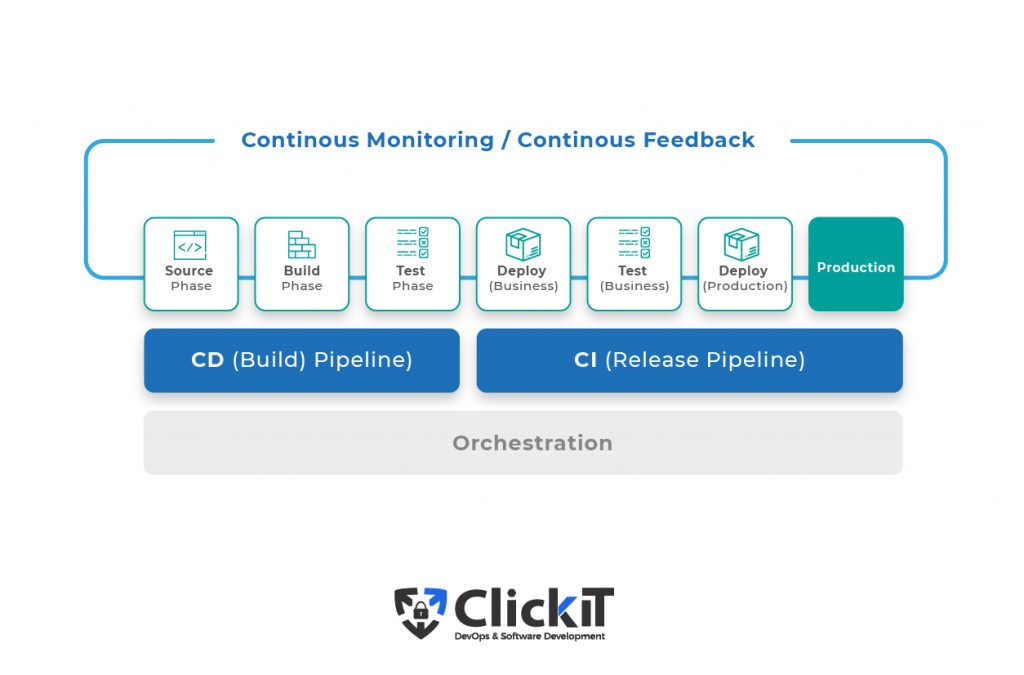
To fully leverage the CI/CD process, the pipeline should be rightly designed and the right tool stack should be identified. The entire process should be optimized too. Jenkins, Gitlabs, CircleCI are some popular tools available for CI/CD processes.
DevOps companies do: Microservice architecture and App Modernization
In today’s fast-paced technology world, technologies are rapidly changing. Be it unexpected traffic spikes, changing business requirements, security requirements, or fault-tolerance issues, business processes should be relevant to this space. Microservices architecture rightly fits into the cloud-based DevOps environments
Microservices is a type of software architecture wherein complex software is broken into smaller, loosely coupled, and independent services that communicate with each other via language-agnostic APIs. The granularity enables organizations to create independent services for each service and scale specific elements.
By not being dependent on specific databases, Microservices architecture enables you to create distributed systems with decentralized management. You can build one microservice unit for a specific service. With language-agnostic, OS-agnostic, and database-agnostic ability, microservices enable you to choose your desired technology stack and solutions. There are no dependencies as well.
Microservices architecture enables application modernization wherein you can refactor legacy apps when migrating them to the cloud to preserve and conserve the business value it offers to the organization. You can either replace it at a micro-level, unchanging the technology and the core architecture, or at the module level replacing certain functions or modules or perform a complete transformation.
“The right DevOps Company will walk you through the process.”
Choosing an application to modernize and perform the level of transformation is a tricky task. If the app is built on main-frame languages and tightly coupled with old databases or poorly designed, it is not feasible to modernize it. Creating it from scratch would be a feasible idea. You need to identify how to break the app into smaller components, right into its primitive functionality, how to provide data access through data services, and how to perform testing.

The Kubernetes API defines the desired state of the Kubernetes cluster using the command line or directly interacting with the cluster. The state is defined in config files called manifests using JSON or YAML. They contain the details of running apps, workloads, and available resources for the apps, etc. So, Kubernetes ensures that the cluster is maintained at the desired state. For instance, if you define 2 replicas of an app to run at a specific time and one of the app instances crashes, Kubernetes will automatically run one more app.

DevOps companies do: SaaS architecture
Most of today’s apps are delivered over the cloud. As such, SaaS architecture has become an inevitable choice for Independent Software Vendors (ISVs). SaaS is a short form of Software-as-a-Service and is one of the popular cloud deployment models. In this model, applications are centrally hosted in the cloud and are delivered over the internet on a subscription basis.
SaaS architecture enables organizations to deliver a single app to multiple clients. It comes in two variants. Vertical SaaS architecture caters to a specific verticals such as healthcare, finance, HR, etc. Horizontal SaaS architecture caters to a specific department and is industry-agnostic.
One of the tricky choices is implementing a single tenant SaaS architecture versus a multi-tenant one. In a single-tenant architecture, resources such as hardware, infrastructure, and software ecosystem are dedicated for each organization, resulting in multiple standalone environments. ISVs have to manage hundreds of code repositories for each customer. Server management costs and complexities consequently increase. In a multi tenant architecture, a single environment that is logically isolated is shared by multiple clients. With a single source of code, it becomes easy to manage code while reducing server infrastructure costs and increasing time to market as well.

DevOps company do: PCI, HIPAA and SOC2 compliance
PCI DSS, HIPAA, SOC 2, etc. are a few regulations that USA-based organizations should comply with.
PCI DSS: PCI DSS stands for Payment Card Industry Data Security Standard. It involves a set of guidelines issued by the USA authorities to be followed by organizations that process credit card information.
Download the free PCI DSS Compliance Checklist on AWS!
HIPAA: HIPAA stands for The Health Insurance Portability and Accountability Act of 1996. It is a Federal regulation that requires healthcare institutions to not disclose patient information without the consent of the patient.
Know more about our HIPAA Compliance services.
SOC 2: It is an external audit that checks how well the service provider cares about information security, by assessing five metrics namely security, availability, confidentiality, process integrity, and privacy. While SOC 2 compliance is not a compulsion for US-based SaaS companies, it ensures that your data is secure and safe.
When the right DevOps strategy is implemented across the organization, it will automatically comply with all these regulations and makes auditing easy.
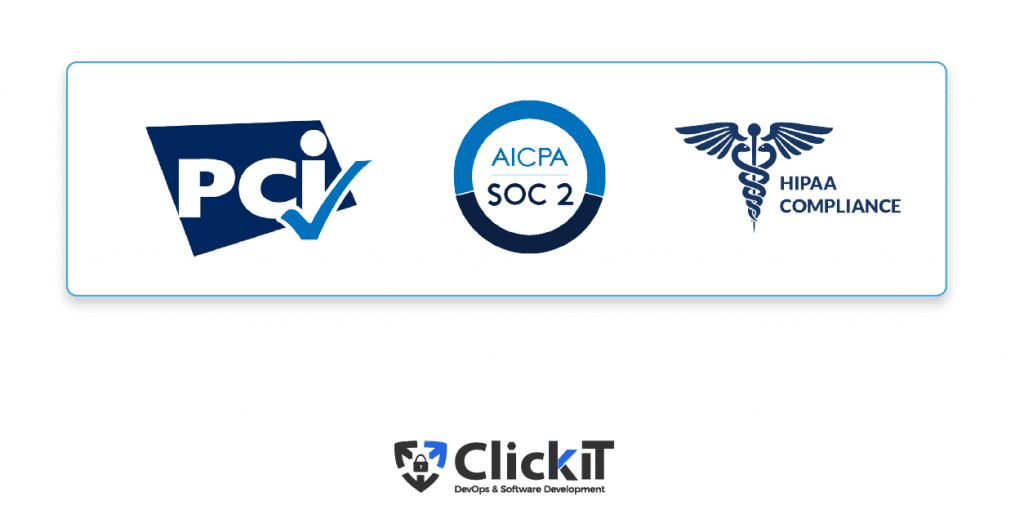
DevOps companies do: Upscaling Web Applications
As organizations deliver resources over the cloud, scaling web applications becomes a key concern. In a basic scenario, a web server takes requests from end-users, contacts the data server, and delivers the required info to the end-user. As the traffic grows, the webserver won’t be able to cater to that traffic. So, you’ll have to perform vertical scaling or horizontal scaling. The single point of failure is another concern.
When you perform horizontal scaling by adding more servers, you need to route the traffic to corresponding servers. So, you’ll need to install load balancers. To avoid a single point of failure, you’ll need to add multiple load balancers. Load balancers should also be able to check the available server and route the traffic to that server. Remembering sessions to route a repeated user to the same server is another challenge. So, you’ll have to set up Redis servers to store session information. Managing cache to remember users is another task.
Along with multiple web servers, you’ll have to manage multiple database servers as well using techniques such as replication and sharding. Everything should be automated as well.
Leading DevOps companies in the United States can efficiently orchestrate these tasks.

How to choose DevOps companies for your enterprise?
Choosing the right DevOps company is the key to fully leveraging this innovation. Here are some aspects to look at while screening the profiles of DevOps companies in USA.
“Choosing the right DevOps company is the key.”
DevOps technical expertise
Firstly, the company should have at least 4-6 years of experience in efficiently managing the DevOps tool stack. Check out their expertise in using infrastructure as code tools such as Terraform, CloudFormation, or configuration management tools like Chef, Puppet, Saltstack, etc. Find out their proficiency in working with CI tools such as Jenkins, CircleCI, etc. Code deployment, database management, and system architecture and design is another area to look at. It would be beneficial if the company has expertise in the tool stack that your organization is comfortable with and complies with your IT goals and policies. In addition, Kubernetes clustering, microservices architecture, and feedback metrics are important.
Checking out the DevOps strategy of the company is another key consideration. For instance, ClickIT uses a proven strategy that has empowered several organizations.
- Stage 1: Normalization enables DevOps with the introduction of the right tool stack.
- Stage 2: Standardization streamlines the delivery and deployment pipeline.
- Stage 3: Teams gain more autonomy and seamlessly collaborate across cross-functional teams.
- Stage 4: Systematic decoupling between processes and systems begins and automation is focused.
- Stage 5: More automation with a self-service system
Consider the operating costs of the tool stack and their availability with the cloud service providers.

Communication
Communication is the key to seamless collaboration between teams in an organization. In a DevOps environment wherein cross-functional teams are required to collaborate, communication becomes even more important. With a top-down approach, every member should be aware of what’s happening in the organization.
The workflow, feedback, and continual learning are 3 important keys to a successful implementation of DevOps methodology. It will be achieved only when there is proper communication across teams. As such, the company you choose should be able to properly communicate with teams. English proficiency is a key requirement as well.
Before hiring a DevOps company in California, it is important to check how well they communicate in terms of vocal and text. You can check the reports and emails to find out about this aspect.
The benefits of good communication are better quality of projects, solve problems faster, live collaboration, shorter feedback loops, among others.
International Recognition
Checking out if the company has international recognition is a key aspect as well. As a US-based company, your primary requirement is that the DevOps company at least has recognition in this region. US, Canada, and UK markets account for the majority of usage of DevOps technologies. As such, an experienced DevOps company should have worked for these companies with international recognition.

Case studies of DevOps Companies in USA and California
While DevOps is a universal concept, it makes sense to check if the DevOps company previously worked for US-based organizations. If the company can show a case study of a California-based company, that would be an added advantage as DevOps is not just about tools and technologies but also about culture. DevOps companies that worked with California-based companies have a hang of the Californian culture. It facilitates better communication and collaboration between your organization and the DevOps company. Making a cultural shift becomes easy too.

ClickIT displays multiple case studies on its website. For instance, Eplexity is a cloud management and consulting firm that offers services in Automated Cloud Architectures, Cloud Consulting, and Cloud Managed Services. They needed to scale and extend his current Cloud and DevOps consulting team with a nearshore DevOps partner. ClickIT implemented AWS technologies for easier management and determined the best tool for the migration required.
Reviews and testimonials
While the company can talk hours together about themselves, it is your duty to check out their reputation and work experience. One way to do this is to check their reviews and ratings online. While reviewing the profiles of multiple DevOps companies in USA, considering key metrics such as pricing, expertise, positioning, and ratings, etc. is essential.
For instance, Clutch is a popular site that offers unbiased reviews from IT analysts. Glassdoor is another site that reviews companies and DevOps salaries paid to its employees. If the company has all 5 stars which means every customer was completely satisfied with the work delivered by the company. Another aspect to look at is the minimum project price. The company should offer a decent hourly rate or a minimum project size. Checking out the focus area is important as you will get to know the expertise levels of the professional in that area. Finally, take time to read some of the reviews to know the customer experience.
ClickIT reviews can be found on Clutch and Glassdoor. You can also check their LinkedIn profile to know more about the company and what US clients think about them.
The voice of the customer
DevOps companies that are aligned with your industry and vertical
Leading DevOps companies are well versed with the methodologies, tool stack, and processes. However, the DevOps company that you intend to work with should align with your industry and vertical. Every industry has a specific set of pain points and challenges. If your organization is into healthcare, you’ll have to deal with providing quality care, comply with HIPAA, integrate all healthcare-related services, etc. A DevOps company that can align with Healthcare can easily understand healthcare industry pain points and challenges.
Ask for USA/California or Texas Referrals
While companies publish case studies and partner lists on their company’s ‘About Us’ page, it is important to reach out to these clients to verify the authenticity of their work. Asking for USA, California, or Texas referrals is the best way to do so. Ask the DevOps company to provide 2-3 referrals from the US and specifically from the California region. Contact these clients without any hesitation and enquire about the performance of the company and their customer experience. The warmer is the response, the greater is the customer experience. Referrals specifically from California or from Texas help you to understand how well the company brought out a cultural shift and was able to jell with them.
Cultural alignment between you and your DevOps company
The synonym to ‘implementing DevOps’ in an organization is ‘embracing change’. Cross-functional teams are formed with shared objectives and responsibilities. A developer who normally writes the code might have to wear the hat of a tester or an Ops guy to deploy the code as well. Roles become indistinct and the focus shifts to delivering quality products faster. When shared responsibilities come into picture, seamless coordination and collaboration becomes a key requirement. When everyone is accountable for the quality of the product, employees give more than 100%.
When a developer gets to know the pain points of operations team tasks, he would write code keeping these points in view. Similarly, when an ops guy knows how the code behaves and works, infrastructure management becomes easy and reliable. It helps in automating the entire CI/CD pipeline, working with a single source of truth and reliably managing infrastructure using code.
With traditional organizational culture deep-rooted into everyone, embracing this change is the most challenging part for employees as well as employers.
So, not only is a top-down cultural shift in your organization important but it should also align with that of the DevOps company. So, take extra care to compare the cultural aspects of your organization with those DevOps companies.
For instance, ClickIT believes that the organization culture plays a significant role in leveraging DevOps benefits. Cultural shift at ClickIT went through a top-down approach, implementing DevOps methodologies at the smallest units. Secondly, engineering teams were provided with autonomy to own and control responsibilities that are integrated right into the process. Being accountable and autonomous makes each member crave for quality that improves testing procedures as well. Encouraging employees for the right things they do with rewards and recognition adds up to a healthy workstyle.
ClickIT has one more advantage when it comes to culture. This Saltillo-based company falls into the geographical proximity of California and is well versed with the Californian culture making it easy to get going with your employees from day one.
Good DevOps engineering salary and benefits
Checking out the DevOps salaries and benefits offered by companies in the US to its employees might sound strange. However, it completely makes sense as you get to know how satisfied DevOps engineers are with their employers. You can check out these details on sites such as Glassdoor and Indeed. Glassdoor reports that the average annual salary of a DevOps engineer in the US is $102,303, PayScale keeps it at $96,239 while Indeed shows it as $122,197 with a cash bonus of $6,863 per year. For a senior Devops engineer, the average salary is $142,139 per annum while highly experienced DevOps engineers earn up to $175,000 per annum, as reported by Talent.com. Interestingly, California records the highest average annual salary for senior DevOps engineers which is $160,000, followed by New York with $155,000 and Massachusetts with $145,000. The salary amount changes with the role, responsibility, experience, and project, etc.
It is important to check other benefits as well. Does the company offer insurance and a Christmas bonus to its employees? Does it encourage them by offering performance bonuses, rewards and recognitions etc. These small things make a big difference in the work style of employees. You can also read employee reviews to check how well the organization cares about its employees and how satisfied employees are with the company.
All DevOps engineers at ClickIT are fully satisfied with the company as they receive good packages along with insurance, Christmas bonus, performance bonus and rewards etc.
Dynamic DevOps company
Another important consideration while narrowing down DevOps companies is to check if the company is static or dynamic. Gone are the days when you open an office, work on a project and call it a day. Today, the company should always be seen and felt online. Running a YouTube channel or a Podcast is a good idea. By posting videos and running podcasts, the company can provide required technical information to users while being able to be in touch with them. It also speaks about their enthusiasm and efforts in being up to to date with the latest technologies.
What about the technical content offered on the site? Does the company offer eBooks, white papers, how-tos, and other technical stuff? Maintaining a blog is a minimal requirement today. Looking at the blog, you can understand what’s happening at the company.
For instance, ClickIT is a dynamic nearshore DevOps company that has a good digital footprint.
ClickIT counts with a broad repertory of extra resources such as our blog page which has the latest topics on DevOps and Software Development, we also count with a Youtube channel to watch culture videos, customer testimonials, and DevOps chats, which you can watch at any time. And if you’re more a lecture guy, you can also rely on our unique ebooks, portfolios, and case studies, and why not? If you prefer you can also find our podcasts and webinars on the resource page.
DevOps collaboration models
Organizations that intend to hire DevOps services company can hire a DevOps consultant, hire an in-house DevOps engineer or opt for nearshore dedicated DevOps engineers.
Nearshore Dedicated Senior Devops Engineer
Hiring the services of a nearshore dedicated senior DevOps engineer is a beneficial option for organizations based in the USA. Firstly, it gives them access to senior DevOps engineers who are experienced in efficiently implementing DevOps practices in organizations. Secondly, hiring a nearshore DevOps company eliminates the pain of finding the right Devops talent. Working within similar time zones with minimal cultural differences is an added advantage. Both companies are based in the same region, they comply with similar governing regulations. So, auditing becomes easy, and security is higher. Shorter trips for business meetings reduce travel costs.
The charges are relatively less. For instance, ClickIT charges $6000-$7000 per month for a senior DevOps engineer using a fixed price model based on the number of hours required for the project.
Hiring an In-house DevOps Engineer
A DevOps Engineer is a certified DevOps professional who actually implements DevOps strategies designed by the consultant company or an in-house DevOps architect. The challenge with in-house DevOps engineers is that it is hard to find qualified professionals. They are expensive too. A DevOps engineer is paid something around $120,000 per year. Another concern is that DevOps engineers would either come from a system admin background or a developer background and obviously, their competence lies in that area. So, choosing the right engineer for the right task is the key.
Hiring a DevOps Consultant
A DevOps consultant is normally hired to perform a specific task, analyze the system and offer optimization strategies, or train employees on DevOps tools and processes. These DevOps certified professionals mostly offer solutions that are later implemented by a DevOps engineer. While DevOps consultants are certified professionals and have expertise in this area, they charge a whopping amount of $150-$300 per hour. Another concern is the accountability of these professionals. As they are not part of the product life cycle, team spirit can be affected.

Why a nearshore DevOps engineer can be a better strategy than an in-house DevOps engineer?
Most organizations struggle to choose between nearshore IT professionals and in-house IT professionals. When it comes to DevOps practices, choosing a nearshore DevOps engineer is a better strategy.
When you hire an in-house DevOps, you can have face-to-face collaboration and direct communication. Language is compatible and standard working hours are available. However, they come with a certain price. Firstly, on-shore software development is mostly costly when compared with nearshore or offshore IT development. Scaling IT capacity as per business requirements is challenging. Secondly, DevOps processes constantly change, and full-time staff skills can become obsolete with time. Thirdly, the market is in dearth of skilled DevOps engineers and it becomes an additional burden for organizations to go through this hiring process.
Nearshore DevOps engineers come without these challenges. As they are based within the geographical proximity, you can quickly arrange offline meetings to have a face to face collaboration. Secondly, the minimal cultural difference helps the organizations to gel with the professionals quickly. Thirdly, you can always choose the right talent from the nearshore company for the required project or task without worrying about changing technologies.
Fourthly, the nearshore DevOps engineer comes at a lesser price. For instance, USA-based DevOps engineers charge $120,000 per year, while the same roles are valued at $66,000 to $80,000 in Mexico. However, these engineers possess a similar culture and are governed by the same IT regulations. As such, Mexican DevOps engineers are more accountable and cost-effective when compared with offshore engineers.
If you are interested in outsourcing in Latam, read our blog Top IT Outsourcing Companies in LATAM
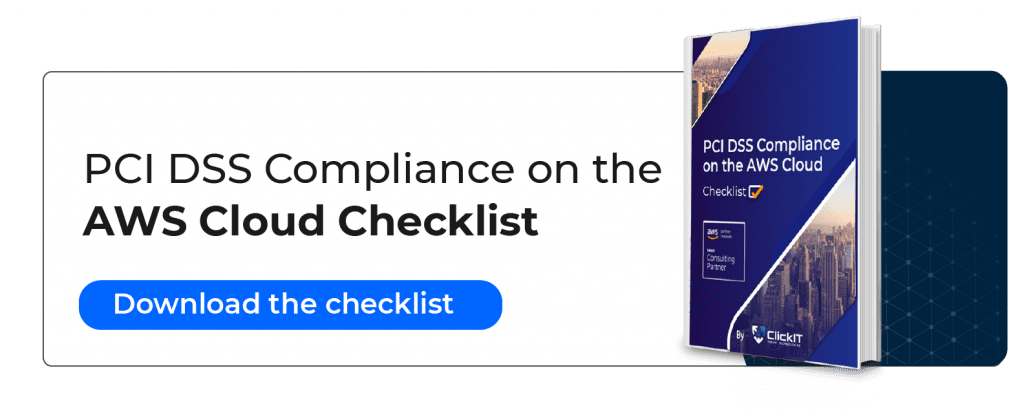
Offshore DevOps Services Vs Nearshore DevOps Services
An Offshore DevOps company is one that is located far away from the outsourcing country and has a different timezone. A nearshore DevOps company is one that is located in a nearby country and falls within the same time zone.
Both offshore and nearshore DevOps services come with their own pros and cons. When you hire an offshore company for your DevOps needs, you’ll have a wide area to search for the required skills and talent. Global talent pool is obviously larger. Secondly, offshore services are cheaper as you can choose talent from developing countries wherein the hourly rate is a lot cheaper when compared with USA and UK charges. Thirdly, rotating shifts is a big advantage. You can assign a task and go to sleep and get the work done when you get up in the morning. However, the same time zone difference can become a hurdle to seamless collaboration that affects the deliverables. Cultural differences are a big issue that affects seamless collaboration and communication with cross-functional teams. Considering the distance, travel becomes expensive.
Nearshore DevOps services offer certain benefits such as similar time zones, seamless collaboration, face-to-face communications, minimal cultural differences, easy audits, and shorter business trips. However, the only downside is that there are not many quality DevOps companies within the region.

Frequently Asked Questions (FAQ)
A DevOps company is a software company that offers a team of DevOps professionals to rightly implement DevOps practices in the organization. Right from streamlining and automating application development and transforming application delivery to orchestrating infrastructure management and fully leverage the cloud, DevOps companies help organizations manage the entire DevOps product lifecycle.
Here are the best DevOps companies in the USA and California
1) ClickIT offers Software development and DevOps services
2) DevOps Prodigy is a full-service website infrastructure company.
3) CloudTern offers DevOps services for Digital Service Providers, Healthcare, and ISVs.
4) Zibtek offers on-demand developers for software development services.
DevOps consulting companies analyze your processes and provide optimized DevOps strategies to upscale your business. They offer DevOps consultants who can resolve specific issues in the company or train your employees on DevOps stack and processes.
As DevOps is not a tool or a technology, there are no standard guidelines for implementing it. However, companies that have successfully leveraged DevOps have first identified business objectives and defined DevOps for the organization accordingly. Then, they created cross-functional teams with shared objectives and metrics. They also identified applications to move to DevOps, eliminated constraints and developed the toolchain to finally scale up.
Here is a detailed explanation of implementing DevOps in an organization:
https://www.clickittech.com/devops/devops-strategy/
Here are the top 5 companies that are leveraging DevOps:
Amazon
Netflix
Walmart
Facebook
Etsy
A DevOps partner is a nearshore software development company that partners with an organization to help them with specific DevOps needs.
DevOps costs vary with the type of collaboration model. For instance, a nearshore company charges $6000-$7000 per month for a DevOps senior engineer. Travel costs for business meetings are less considering 1.5 – 5 hours of flight. The project costs come down to $15-$25 per hour. When you hire an in-house DevOps engineer, you have to pay $10,000 per month. DevOps consultants charge $150-$300 per hour.

